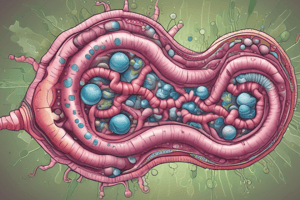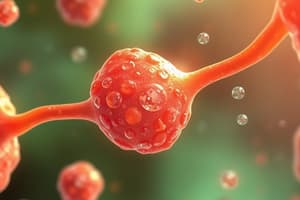Podcast
Questions and Answers
What is the majority of lipids that we ingest in the form of?
What is the majority of lipids that we ingest in the form of?
triacylglycerol
What are the other types of lipids that we ingest besides triacylglycerol?
What are the other types of lipids that we ingest besides triacylglycerol?
cholesterol, cholesterol esters, phospholipids, and free fatty acids
What does the mouth secrete to digest lipids?
What does the mouth secrete to digest lipids?
lingual lipase
When is lingual lipase activated?
When is lingual lipase activated?
When is gastric lipase activated?
When is gastric lipase activated?
What does gastric lipase act best on?
What does gastric lipase act best on?
Why does digestion of lipids not occur until the duodenum in adults, regardless of lipase?
Why does digestion of lipids not occur until the duodenum in adults, regardless of lipase?
What emulsifies fats and where does it derive from?
What emulsifies fats and where does it derive from?
What is cholesterol attached to in bile salts?
What is cholesterol attached to in bile salts?
What are the bile salts?
What are the bile salts?
Describe the structure of bile salts?
Describe the structure of bile salts?
What are bile acids?
What are bile acids?
Are bile acids found in bile?
Are bile acids found in bile?
What degrades emulsified triacylglycerols, cholesterol esters, and phospholipids?
What degrades emulsified triacylglycerols, cholesterol esters, and phospholipids?
What does pancreatic lipase break triglycerides into?
What does pancreatic lipase break triglycerides into?
What do cholesterols get broken into by pancreatic esterase?
What do cholesterols get broken into by pancreatic esterase?
What do phospholipids (phosphatidyl-choline) get broken into?
What do phospholipids (phosphatidyl-choline) get broken into?
What breaks down phosphatidyl-choline and what activates that?
What breaks down phosphatidyl-choline and what activates that?
What breaks the second fatty acid from carbon 1 of phosphatidyl-choline?
What breaks the second fatty acid from carbon 1 of phosphatidyl-choline?
What is the second fatty acid of phosphatidyl-choline called?
What is the second fatty acid of phosphatidyl-choline called?
Where are micelles found?
Where are micelles found?
What are the primary products of lipid catabolism in the intestine?
What are the primary products of lipid catabolism in the intestine?
Where do bile salts get reabsorbed?
Where do bile salts get reabsorbed?
What happens to bile salts after they are reabsorbed?
What happens to bile salts after they are reabsorbed?
What do intestinal mucosal cells do to the absorbed fatty acids?
What do intestinal mucosal cells do to the absorbed fatty acids?
What goes into conversion of fatty acid to fatty acyl CoA?
What goes into conversion of fatty acid to fatty acyl CoA?
What can be done with fatty acyl CoA once it is made?
What can be done with fatty acyl CoA once it is made?
What is the product of 2 fatty acyl CoAs + 1 monoacylglycerol?
What is the product of 2 fatty acyl CoAs + 1 monoacylglycerol?
What enzyme produces triacylglycerol + 2 CoA?
What enzyme produces triacylglycerol + 2 CoA?
What does the acyl transferase group do?
What does the acyl transferase group do?
What are acyl transferases specific to?
What are acyl transferases specific to?
What does acyl transferase do to long chains?
What does acyl transferase do to long chains?
What else can acyl transferase do with FFAs to cholesterol or lysophospholipids?
What else can acyl transferase do with FFAs to cholesterol or lysophospholipids?
How do amino acids get converted to the lymphatic system?
How do amino acids get converted to the lymphatic system?
What is the main apoprotein?
What is the main apoprotein?
How do lipids travel in the blood to cells that need them?
How do lipids travel in the blood to cells that need them?
Where do chylomicrons enter circulation?
Where do chylomicrons enter circulation?
Where are chylomicrons exocytosed?
Where are chylomicrons exocytosed?
What uses triacylglycerols?
What uses triacylglycerols?
How is triacylglycerol broken down in chylomicrons?
How is triacylglycerol broken down in chylomicrons?
What makes and secretes lipoprotein lipase?
What makes and secretes lipoprotein lipase?
What is chylomicron triacylglycerol broken down into by lipoprotein lipase?
What is chylomicron triacylglycerol broken down into by lipoprotein lipase?
How can the FFAs from triacylglycerol in circulation be used?
How can the FFAs from triacylglycerol in circulation be used?
Where is glycerol used?
Where is glycerol used?
What happens with the remainder of a chylomicron?
What happens with the remainder of a chylomicron?
What forms of lipoproteins are found in the life cycle of lipids?
What forms of lipoproteins are found in the life cycle of lipids?
What do apolipoproteins found in lipoproteins provide?
What do apolipoproteins found in lipoproteins provide?
What is the primary function of chylomicron?
What is the primary function of chylomicron?
What is the primary function of VLDLs?
What is the primary function of VLDLs?
What is the function of LDLs?
What is the function of LDLs?
What is APO CII needed for?
What is APO CII needed for?
Why are HDLs good cholesterol?
Why are HDLs good cholesterol?
How do you identify an HDL?
How do you identify an HDL?
Flashcards
What is the majority of lipids we ingest?
What is the majority of lipids we ingest?
triacylglycerol (90%)
What is the remainder of the lipids we ingest?
What is the remainder of the lipids we ingest?
cholesterol, cholesterol esters, phospholipids, and free fatty acids
What does the mouth secrete to digest lipids?
What does the mouth secrete to digest lipids?
lingual lipase
When is lingual lipase activated?
When is lingual lipase activated?
Signup and view all the flashcards
What does the stomach secrete to digest lipids?
What does the stomach secrete to digest lipids?
Signup and view all the flashcards
When is gastric lipase activated?
When is gastric lipase activated?
Signup and view all the flashcards
What does gastric lipase act best on?
What does gastric lipase act best on?
Signup and view all the flashcards
How is acidity different in a baby's stomach?
How is acidity different in a baby's stomach?
Signup and view all the flashcards
Why does digestion of lipids not occur until the duodenum in adults, regardless of lipase?
Why does digestion of lipids not occur until the duodenum in adults, regardless of lipase?
Signup and view all the flashcards
What emulsifies fats and where does it derive from?
What emulsifies fats and where does it derive from?
Signup and view all the flashcards
What is cholesterol attached to in bile salts?
What is cholesterol attached to in bile salts?
Signup and view all the flashcards
What are the bile salts?
What are the bile salts?
Signup and view all the flashcards
What is the structure of bile salts?
What is the structure of bile salts?
Signup and view all the flashcards
What are bile acids?
What are bile acids?
Signup and view all the flashcards
Are bile acids found in bile?
Are bile acids found in bile?
Signup and view all the flashcards
What degrades emulsified triacylglycerols, cholesterol esters, and phospholipids?
What degrades emulsified triacylglycerols, cholesterol esters, and phospholipids?
Signup and view all the flashcards
What does pancreatic lipase break triglycerides into?
What does pancreatic lipase break triglycerides into?
Signup and view all the flashcards
What do cholesterols get broken into by pancreatic esterase?
What do cholesterols get broken into by pancreatic esterase?
Signup and view all the flashcards
What do phospholipids (phosphatidyl-choline) get broken into?
What do phospholipids (phosphatidyl-choline) get broken into?
Signup and view all the flashcards
What breaks down phosphatidyl-choline and what activates that?
What breaks down phosphatidyl-choline and what activates that?
Signup and view all the flashcards
What breaks the second fatty acid from carbon 1 of phosphatidyl-choline?
What breaks the second fatty acid from carbon 1 of phosphatidyl-choline?
Signup and view all the flashcards
What is the second fatty acid of phosphatidyl-choline called?
What is the second fatty acid of phosphatidyl-choline called?
Signup and view all the flashcards
Where are micelles found?
Where are micelles found?
Signup and view all the flashcards
What are the primary products of lipid catabolism in the intestine?
What are the primary products of lipid catabolism in the intestine?
Signup and view all the flashcards
Where do bile salts get reabsorbed?
Where do bile salts get reabsorbed?
Signup and view all the flashcards
What happens to bile salts after they are reabsorbed?
What happens to bile salts after they are reabsorbed?
Signup and view all the flashcards
What do intestinal mucosal cells do to the absorbed fatty acids?
What do intestinal mucosal cells do to the absorbed fatty acids?
Signup and view all the flashcards
What goes into conversion of fatty acid to fatty acyl CoA
What goes into conversion of fatty acid to fatty acyl CoA
Signup and view all the flashcards
Study Notes
Lipid Digestion and Absorption
- Ingested lipids are primarily triacylglycerols (90%).
- Remaining lipids include cholesterol, cholesterol esters, phospholipids, and free fatty acids.
- Lingual lipase is secreted in the mouth.
- Lingual lipase is activated in the stomach (acid-stable).
- Gastric lipase is secreted in the stomach.
- Gastric lipase is activated in the duodenum (neutral pH).
- Gastric lipase primarily acts on triacylglycerols with short or medium-chain fatty acids (like in milk).
- In infants, the stomach's more neutral pH activates gastric lipase, allowing lipid digestion of milk in the stomach.
- Lipid digestion in adults isn't initiated until the duodenum due to the need for emulsification (low water solubility).
- Bile (bile salts), derived from cholesterol in the liver, emulsifies fats.
- Bile salts contain a hydrophobic region for binding fat and a hydrophilic region for water solubility.
- Bile salts are either glycocholate or taurocholate.
- Bile acids (cholic acid and chenodeoxycholic acid) are precursors to bile salts.
- Bile acids are found in the intestine due to bacterial breakdown of bile salts.
- Pancreatic enzymes degrade emulsified triacylglycerols, cholesterol esters, and phospholipids.
- Pancreatic lipase breaks triglycerides into two free fatty acids (from C-1 & 3) and a 2-monoacylglycerol (attached to C-2).
- Pancreatic esterase breaks cholesterol into cholesterol and one free fatty acid.
- Phospholipids are broken down into a fatty acid (C-1) + a fatty acid (C-2) by the pancreatic enzyme Phospholipase A2 (activated by trypsin).
- Lysophospholipase breaks down a second fatty acid from the C-1 of Phosphatidyl-choline (glyceryl-phosphoryl-choline).
- Micelles are found in the lumen of the small intestine.
- Primary products of lipid catabolism in the intestine are free fatty acids, cholesterol and 2-monoacylglycerols.
- Bile salts are reabsorbed in the ileum.
- Recirculated bile salts go back to the liver to be reused.
Lipid Absorption and Transport
- Intestinal mucosal cells convert absorbed fatty acids to fatty acyl CoA (using fatty acyl CoA synthase).
- Two fatty acyl CoAs and one monoacylglycerol combine to form triacylglycerol and two CoA molecules (using acyltransferase).
- Acyltransferases are specific to fatty acid chain-length.
- Long-chain fatty acids become part of triglycerides.
- Short-chain fatty acids enter the blood bound to albumin.
- Acyltransferases can also form cholesterol esters or phospholipids from fatty acids and cholesterol or lysophospholipids.
- Amino acids combine with apoproteins to form chylomicrons.
- Apolipoprotein B-48 is a key apoprotein in chylomicrons.
- Chylomicrons transport lipids in the blood.
- Chylomicrons enter the bloodstream via the left subclavian vein.
- Chylomicrons are exocytosed into intestinal lacteals.
- Tissues use triacylglycerols.
- Lipoprotein lipase breaks down chylomicron triacylglycerols into glycerol and three free fatty acids.
- Free fatty acids diffuse into neighbouring cells or circulate bound to albumin.
- Glycerol is used in the liver for glycolysis or gluconeogenesis.
- Chylomicron remnants are taken up by the liver.
Lipoproteins (HDL, LDL, VLDL)
- Other lipoproteins (HDL, LDL, VLDL) are involved in lipid transport.
- Apolipoproteins in lipoproteins provide structure, cell recognition, and aid in lipoprotein metabolism.
- Chylomicrons primarily donate fatty acids to tissues.
- VLDL transports triglycerides from the liver to tissues.
- LDL delivers cholesterol to tissues.
- HDL acts as a reservoir for APO CII, transferring it to VLDL and chylomicrons for activation of lipoprotein lipase.
- HDL is 'good' cholesterol because it removes cholesterol from tissues and transfers it to VLDL.
- HDL contains high cholesterol and APO CII and E.
- LDL contains little TG, some CE and PL and APO B100, APO E and APO CII.
- VLDL has lots of TG and APO B-100.
Studying That Suits You
Use AI to generate personalized quizzes and flashcards to suit your learning preferences.




